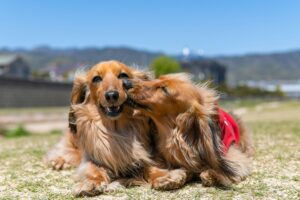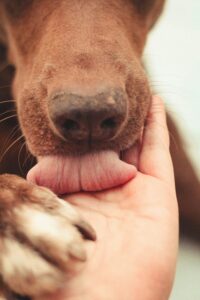Dogs Who Speak Through Touch: Affection in Every Paw and Nose Nudge
From curling up beside you on the couch to gently resting a paw on your knee, dogs often use touch as their primary way to say “I love you.” For many pups, physical closeness is the strongest expression of affection. Just as humans feel connected through hugs and handshakes, dogs create bonds through contact.
In this blog, we’ll explore how dogs use touch to communicate love, the different gestures they rely on, and how you can nurture this tender love language.
The Power of Physical Affection
Dogs are social animals with a deep need for connection. In the wild, wolves huddle close for warmth, safety, and bonding. Domestic dogs have inherited this instinct, often seeking physical closeness to feel secure and connected.
Touch reassures them, lowers stress, and strengthens the bond between dog and owner. When your pup presses against you, paws at your hand, or leans in, they’re expressing trust and affection.
Common Ways Dogs Use Touch to Show Love
Every dog has their own style of showing affection, but here are some common physical gestures:
-
Leaning: Dogs may lean their whole body against you as a sign of trust and closeness.
-
Pawing: Gently placing a paw on your arm or leg often means, “Pay attention to me” or “I want to be close.”
-
Nose nudges: A soft nudge on your hand or face is a loving reminder of their presence.
-
Cuddling: Many dogs enjoy curling up on your lap or snuggling beside you for warmth and comfort.
-
Resting their head: Dogs often rest their head on your lap or chest as a gesture of calm affection.
These behaviors go beyond physical contact—they’re part of your pup’s way of reinforcing your bond.
 Why Dogs Lean on Us
Why Dogs Lean on Us
Leaning is one of the most common ways dogs show affection. It’s their way of seeking closeness and reassurance. While some owners interpret leaning as a dominance behavior, most experts agree it’s a gesture of trust and love.
When your dog presses their body against yours, they’re saying: “I feel safe with you. You’re my comfort zone.”
Pawing for Attention or Love
Dogs that paw at you aren’t always being pushy—they’re often expressing affection. Pawing can mean:
-
They want your attention or interaction.
-
They’re mimicking human touch (like holding hands).
-
They’re offering comfort if they sense you’re upset.
Responding positively to pawing—by petting, talking, or playing—reinforces their love language and deepens your connection.
Nose Nudges and Soft Touches
A nose nudge is a simple yet powerful way dogs remind you of their affection. It may be their way of asking for pets, expressing excitement, or simply saying: “I’m here, and I love you.”
These small touches may seem subtle, but they carry significant emotional weight in canine communication.
 The Science Behind Touch
The Science Behind Touch
Touch benefits dogs in the same way it benefits humans:
-
Reduces stress: Physical contact lowers cortisol (the stress hormone).
-
Boosts bonding: Petting your dog releases oxytocin, the “love hormone,” in both you and your pup.
-
Increases security: Touch reassures dogs, especially during stressful situations like thunderstorms or vet visits.
By leaning into touch, dogs literally lean into the bond they share with you.
How to Nurture This Love Language
If your pup’s love language is touch, here are ways to encourage and reciprocate:
-
Make cuddle time a routine: Set aside time each day to snuggle or sit close.
-
Pet with intention: Focus on their favorite spots (behind the ears, chest, or belly) to show affection.
-
Offer reassurance during stress: Calm them with gentle strokes or by holding them close.
-
Respect boundaries: Not all dogs love constant touch—pay attention to their comfort cues.
When Touch Becomes Overbearing
Sometimes dogs use touch excessively—like constant pawing or leaning—which can signal anxiety or a need for reassurance. If it becomes overwhelming, gently redirect their attention with toys, training, or play while still acknowledging their affection.
Conclusion
Dogs who show love through touch remind us of the power of simple physical connection. Whether it’s a nose nudge, a paw on your lap, or leaning into your side, these gestures are heartfelt expressions of trust and affection. By recognizing and responding to this love language, you strengthen your bond and provide your pup with the reassurance they crave.
So next time your dog rests their head on you or paws at your hand, take a moment to return the gesture. After all, in the language of love, touch speaks volumes.



